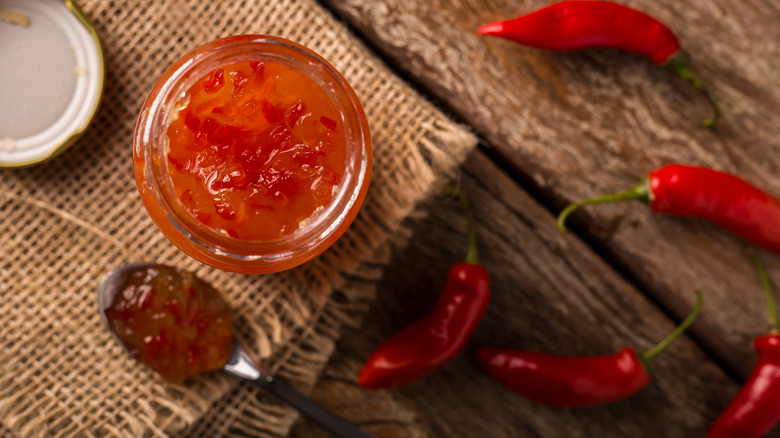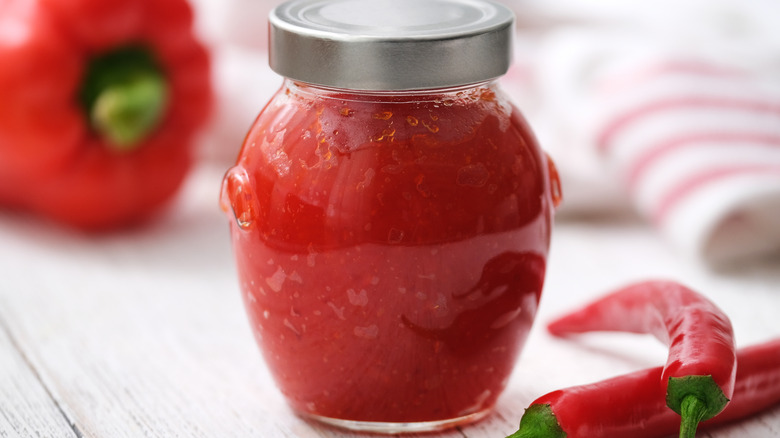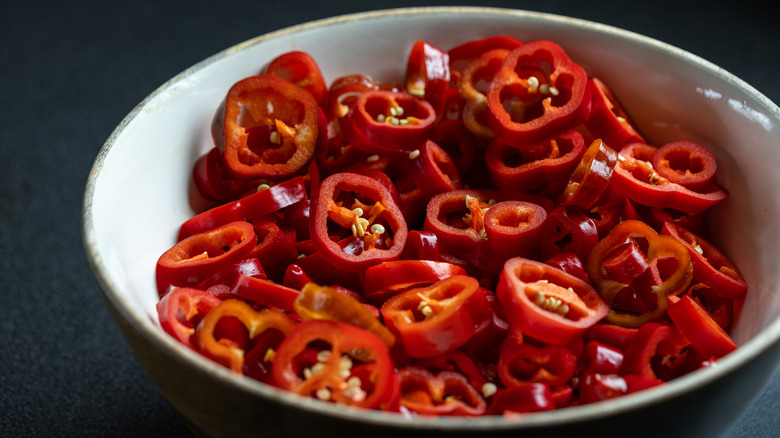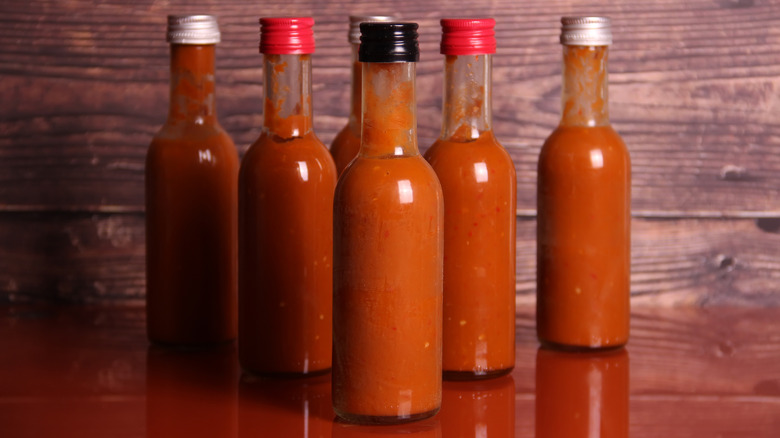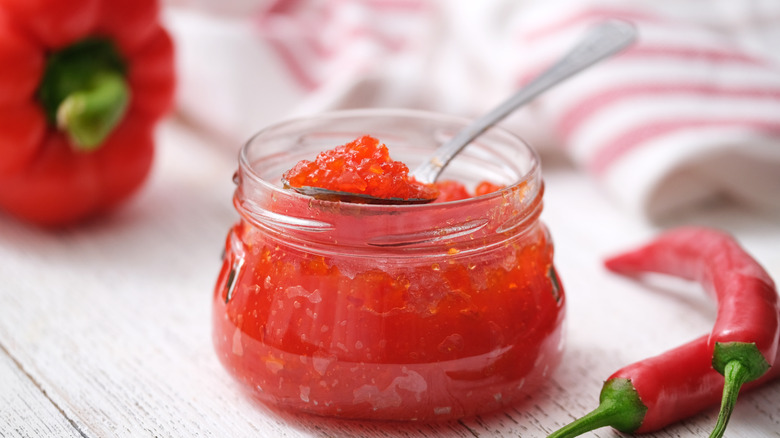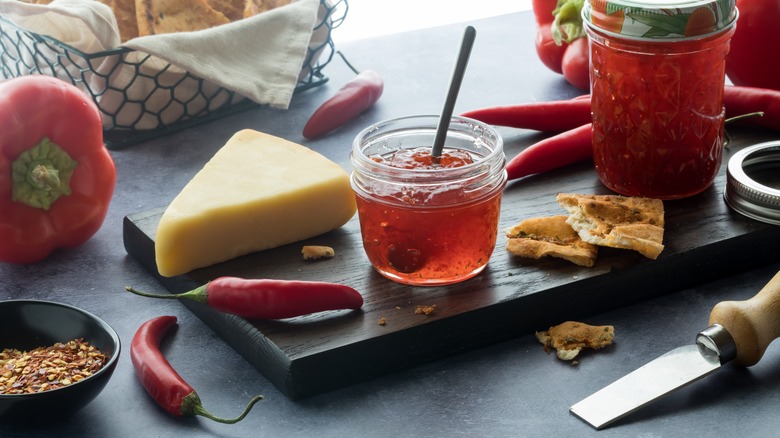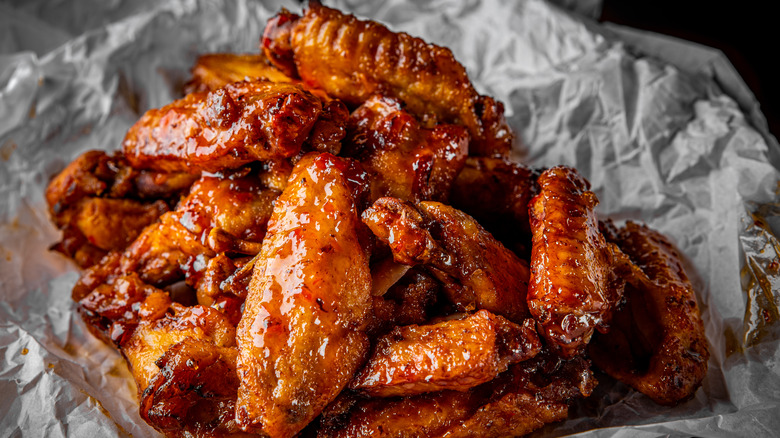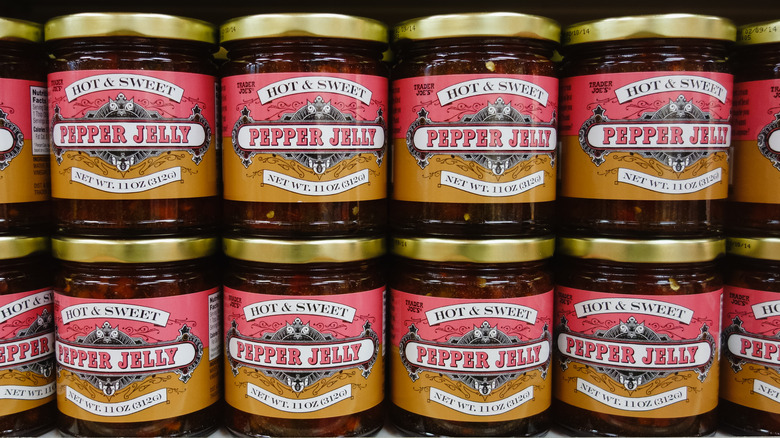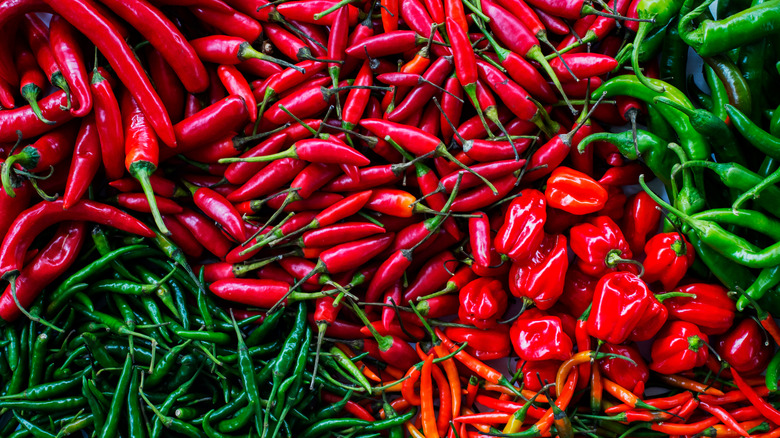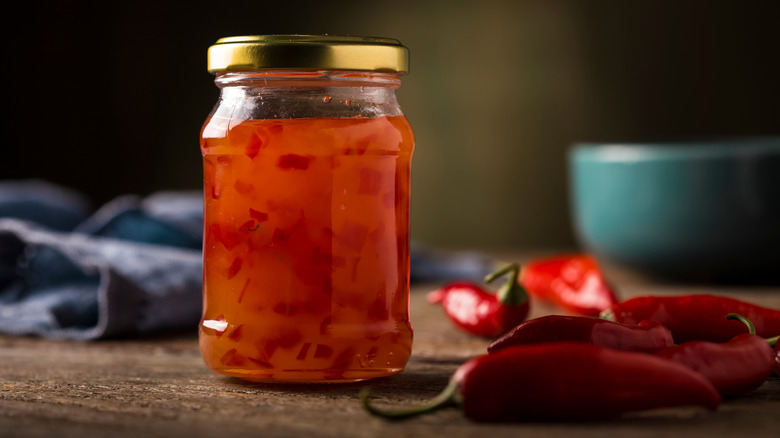What Is Pepper Jelly And How Is It Made?
If you're from the Southern part of the U.S., you're probably already familiar with pepper jelly. It's a sweet, spicy treat that goes as well in a breakfast sandwich as it does at a potluck party or social gathering. With its warm, light taste and bright, colorful appearance it gives some people warm feelings of the bright Spring and Summer months.
It's difficult to say exactly when pepper jelly was first made. What most people can agree on though, is that it was popularized in the 1970s, in Lake Jackson, Texas. Though with the history of both fruit preserves and hot sauce going back for literally thousands of years, there's every chance pepper jelly was being made in people's kitchens long before the rest of the world learned of it.
Today, pepper jelly is enjoyed much farther afield than the Deep South, and can be found in stores and supermarkets across America. If you've never tried it before, here's everything you need to know, so you can brace your tastebuds for a fragrant treat!
What is pepper jelly?
We usually think of peppers as vegetables, but they're actually fruits. This means that, as well as adding their characteristic smoldering burn to savory dishes, they can also be used in much the same way as any other fruit — and that includes making jams and jellies. Pepper jelly is exactly that. Think raspberry jelly, but made with spicy peppers! Which peppers exactly? It really depends on the recipe, but it's usually made with a combination of different varieties to give a fuller flavor. Most recipes call for a mixture of spicy peppers, like jalapeños, combined with sweet bell peppers.
Technically, despite its name, pepper jelly is less like a jelly and more like a jam or marmalade. The difference is that jellies are usually made purely from fruit juice, with all the solids strained out. This gives them a smooth and easily spreadable consistency, so they go perfectly on a piece of hot, toasty bread. Jams, on the other hand, are made with chunks of fruit pulp, softened during the cooking process, while marmalade is made with fruit juice and shredded peel (often citrus), giving them a chunkier consistency. Similarly, most pepper jelly recipes use finely chopped peppers to give the finished jelly extra texture and color from bright flecks of pepper skin.
How is pepper jelly made?
All fruit preserves are made in more or less the same way, and pepper jelly is no different. To make pepper jelly, you start by finely chopping your choice of peppers, then adding them to a pan of boiling water with a combination of sugar, acid, and a pinch of salt to bring out the spicy flavors. Sweet jellies usually use lemon juice as the acid, but for a more savory treat like pepper jelly, apple cider vinegar is a popular choice. To turn it into jelly, the mixture is heated till the sugar dissolves and then boiled together with pectin until it reaches a thick, gloopy consistency. Once finished, it can be poured into jars and, as it cools, it'll set into the thicker jelly we all recognize.
The pectin here is the magic ingredient. This is a large, sugar-like molecule (a polysaccharide) that is found naturally in several types of fruit — unlike gelatin, pectin is completely vegan. Commercially, it's usually extracted from apples or citrus peels, and sold as a dry powder that you can often find on the same supermarket aisle as the baking supplies. Combined with the right amount of sugar and an acid, the pectin is what makes jelly set after it cools. If you're making jelly at home, be sure to use the right amounts of all three of these things, or you can easily end up with syrup instead.
Pepper jelly vs hot sauce
If you're looking for a condiment to bring some heat to your dinner table, there are plenty of options out there, but pepper jelly is quite different than most others. As a fruit preserve, it has a much sweeter taste, and the sweetness gives it a distinct flavor profile, boosting some flavors over others. Hot sauce is probably the best-known spicy condiment out there, but it has a much tangier taste. These characteristic sour notes come from the fact that hot sauce is either fermented or made with vinegar. This accentuates different tastes from the peppers, giving it a very different flavor profile overall. If you're familiar with the sharp savoriness of hot sauce, you'll find pepper jelly very different, and perhaps even too sweet until you get used to it.
There are a couple of other condiments that taste arguably closer to pepper jelly than hot sauce. In terms of sweetness, hot honey is a closer match but, being mostly pure honey, it also has a very different flavor. In a savory dish, the sweetness can be balanced by adding some umami flavor, like soy sauce, to prevent it from being too overpowering. Another thing with a similar taste is Thai sweet chili sauce. Sweet flavors hold a different place in East Asian cuisine instead of being reserved for dessert dishes, so chili sauces often have a much sweeter taste. At the same time, they also usually include other aromatic ingredients like ginger and garlic, which don't feature quite as heavily in most pepper jelly recipes.
What does pepper jelly taste like?
Pepper jelly carries the flavors of whatever types of peppers it's made from. There's a wide variety of different types of peppers out there, and they have many more differences than just their level of heat. For some people, the taste of hot peppers tends to be overshadowed by their spiciness, but many have exceptionally rich and subtle flavors of their own. This can vary from the fragrant, fruity taste of habaneros to the earthy, mild smokiness of serrano peppers.
What this means is that if you have trouble with spicy food, pepper jelly can be a great way to enjoy the taste of the peppers while reducing the intensity of the heat. If you're making your own, you can have even more control over the level of spiciness in your pepper jelly. The hottest part of any pepper comes from the seeds and the ribs they're attached to. Slicing some or all of these out with a sharp knife will help you to make a much milder jelly, if you prefer a gentler burn. If you're handling hot peppers though, it's a good idea to wear latex gloves — the heat can linger on your fingers long after you leave the kitchen!
Varieties of pepper jelly
The beauty of pepper jelly is that there are endless varieties of it. Any kind of pepper can be used, from mild poblano peppers to vibrantly spicy Scotch bonnets. Food scientists have even done studies on what types of pepper work best, with a paper in the Journal of Food Science and Technology concluding that the best pepper jelly comes from red peppers with sweeter, less pungent flavors.
There's more to pepper jelly than just peppers though! It's not hard to find varieties on sale that incorporate other fruits too. Some include light, aromatic fruits like peach, mango, and lime, some use sweeter fruits like strawberries, and others are made with drier-tasting fruits like cranberry and pomegranate. All of these give their own distinctive flavor to the mix, blending with the peppers and sometimes giving a combined flavor different to either. Some pepper jellies are also enhanced with other spicy aromatics like ginger and garlic, adding more depth and complexity. Essentially, as long as the flavors can pair together, there's no limit. Why not see for yourself, with our recipe for apricot jalapeño pepper jelly?
How to cook with pepper jelly
There are plenty of people who prefer not to cook with pepper jelly at all. It's an excellent spread and tastes fantastic in a BLT sandwich or on a toasted bagel. To make the most of its sweet, spicy burn, it can also be mixed with other sauces, like ketchup, to make a tasty barbecue sauce. Pepper jelly also tastes great with cheese and fits perfectly on a cheese board. Some people even like to go a step further and make a savory cheesecake with sharp cheddar, topped with pepper jelly, to be served with crackers.
With that said, if you haven't cooked with pepper jelly, it's definitely worth a try. With its sweetness and texture, it makes a delicious glaze when grilling or roasting meats. If you want to allow the taste of the peppers to shine, you can try using it with milder-tasting meats, like salmon, chicken, or pork. When grilled, the sugar will start to caramelize at the edges, adding darker, slightly smoky flavors to complement the spice. This complexity can also pair nicely with more robust meats like beef, with pepper jelly glazed meatballs being a particularly good choice.
Where to buy pepper jelly
As satisfying as homemade jellies can be, not everyone has the time or kitchen space to make their own. Fortunately, there's no shortage of pepper jellies available for sale. You can find jars of it on the shelves of large supermarket chains like Walmart and Trader Joe's, but you can just as easily order directly from small retailers.
Some small companies produce a range of different pepper jellies, mixing it up by using various types of peppers, as well as other types of fruit. The taste of mango pairs particularly well with the flavor of hot peppers, especially habaneros, so mango habanero pepper jelly is a great choice if you'd like a condiment with a fresher, fruitier flavor. Alternatively, some varieties include some surprising ingredients too, like buttery-tasting pecans; some even include bacon as an ingredient!
If anything, there are so many types of pepper jelly on sale that you could easily find yourself spoiled for choice. If you're not sure where to begin, why not take a look over our ranking of the best pepper jellies and jams on sale?
Nutritional Information for pepper jelly
Thanks to its spicy main ingredient, pepper jelly contains all the same nutrients you can find in the peppers themselves. Cooked peppers are a great source of minerals like magnesium and potassium. They also contain plenty of vitamin A and beta carotene. Many of us will remember our parents telling us that carrots are good for our eyesight, and these nutrients are why — meaning that eating peppers is also good for your eyes!
Being a fruit preserve though, pepper jelly is also full of sugar. A serving size is small, at just a tablespoon, but it still contains about 14 grams of sugar. The World Health Organisation guideline is that we should try not to consume more than 50 grams of sugar in a single day, with some experts recommending that it's ideal to keep your daily intake below 25 grams. In other words, sweet treats like pepper jelly are best enjoyed in moderation. Being so tasty, it's very easy to go over your daily limit.
How to store pepper jelly
Fruit preserves like pepper jelly are designed to last, at least while the jar's still sealed. This is the reason why they contain so much sugar — jams and jellies with over 55% sugar don't have enough water left in them for bacteria to grow, helping to keep them good for longer. An unopened jar of commercially produced jelly can easily last for two years, and a jar of homemade jelly should stay good for one year, even when stored at room temperature in your kitchen cupboard. Just be sure to keep the jar away from sunlight or anywhere too warm.
Once opened though, the clock will start ticking on your jar of pepper jelly. To keep it fresh, you should put it in the refrigerator, where it will stay good to eat for about six months — though to enjoy it at its best, you should eat it sooner rather than later. Outside the fridge, an opened jar of pepper jelly will have a much shorter lifespan and will only keep for about a week. Even in the fridge though, if it's been a while since you opened your jar of jelly, be sure to check it carefully for any signs of mold. If you see any, it's best to toss the jar out and buy a new one, to be on the safe side.
